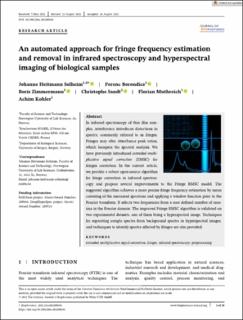| dc.contributor.author | Solheim, Johanne Heitmann | |
| dc.contributor.author | Borondics, Ferenc | |
| dc.contributor.author | Zimmermann, Boris | |
| dc.contributor.author | Sandt, Christophe | |
| dc.contributor.author | Muthreich, Florian | |
| dc.contributor.author | Kohler, Achim | |
| dc.date.accessioned | 2022-03-11T08:56:55Z | |
| dc.date.available | 2022-03-11T08:56:55Z | |
| dc.date.created | 2021-09-24T08:30:06Z | |
| dc.date.issued | 2021 | |
| dc.identifier.citation | Journal of Biophotonics. 2021, 14 (12), . | |
| dc.identifier.issn | 1864-063X | |
| dc.identifier.uri | https://hdl.handle.net/11250/2984508 | |
| dc.description.abstract | In infrared spectroscopy of thin film samples, interference introduces distortions in spectra, commonly referred to as fringes. Fringes may alter absorbance peak ratios, which hampers the spectral analysis. We have previously introduced extended multiplicative signal correction (EMSC) for fringes correction. In the current article, we provide a robust open-source algorithm for fringe correction in infrared spectroscopy and propose several improvements to the Fringe EMSC model. The suggested algorithm achieves a more precise fringe frequency estimation by mean centering of the measured spectrum and applying a window function prior to the Fourier transform. It selects two frequencies from a user defined number of maxima in the Fourier domain. The improved Fringe EMSC algorithm is validated on two experimental datasets, one of them being a hyperspectral image. Techniques for separating sample spectra from background spectra in hyperspectral images, and techniques to identify spectra affected by fringes are also provided. | |
| dc.language.iso | eng | |
| dc.relation.uri | https://onlinelibrary.wiley.com/doi/10.1002/jbio.202100148 | |
| dc.title | An automated approach for fringe frequency estimation and removal in infrared spectroscopy and hyperspectral imaging of biological samples | |
| dc.type | Peer reviewed | |
| dc.type | Journal article | |
| dc.description.version | publishedVersion | |
| dc.source.pagenumber | 18 | |
| dc.source.volume | 14 | |
| dc.source.journal | Journal of Biophotonics | |
| dc.source.issue | 12 | |
| dc.identifier.doi | 10.1002/jbio.202100148 | |
| dc.identifier.cristin | 1937960 | |
| dc.relation.project | Norges forskningsråd: 249844 | |
| dc.relation.project | Norges forskningsråd: 289518 | |
| cristin.ispublished | true | |
| cristin.fulltext | original | |
| cristin.qualitycode | 1 | |
